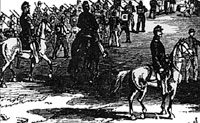One of the most dramatic effects can be achieved by wearing Civil War uniforms when playing a game. If you're not a reenactor with the complete accouterments, just slouch hat or a kepi is good enough. By being dressed in a uniform or hat, one feels more military and more "nineteenth century." Uniforms are useful for demonstration games because they serve to identify the players, which side they are on, and which war is being recreated in miniature.
At a convention, if you, as the referee, wear a uniform, it will make you stand out and will increase your "authority," especially if you wear an officer's uniform. One caveat: leave sabers at home as they tend to swing around and bump into things that should not be bumped, such as furniture and knees.
This combination of the the two hobbies, living history and miniatures, is used to explore both hobbies in a more meaningful way. In fact, reenactors that are also wargamers could sponsor games at conventions or at public places such as the local library. Such scenarios can serve to recruit reenactors from the gamers' ranks or even vice versa. Reenactors can stack rifles nearby and can distribute information about their organizations. Battle flags and photographs of Civil War generals, especially the generals in the battles being reenacted, are good visuals because they serve as a focal point for non-players with only a casual interest in the Civil War. Videos and photos of various reenacting events can be shown to gaming participants during "down times," such as when a large charge combat is being adjudicated on the other side of the table.
Living History
Another way to utilize "living history" involves the way in which the scenario is presented to players. For example, a desktop publishing or word processing program can be used to create players' briefings in the form of local newspapers, scouting reports, capture military orders, (wrapped around cigars, of course), maps, etc. This will serve to give an historic reason for the players to be in the battle. If the players know why they're at a battlefield, playing the game will be more rewarding.
Also, the fog of war can be maintained because you can control what the players know (or don't know) by withholding information or by providing false information. This context might lend some sense of reality and reason although the irony of using modern technology to recreate the nineteenth century is strongly apparent.
Even if the scenario is not intended as a showpiece, certain things can be done to provide the flavor of the Civil War. First and foremost, the snacks that are provided can make a gaming session stand out. Players can sip mint juleps, apple cider, or even partake in a barrelito of whiskey a la Colonel Nathan "Shanks" Evans at Manassas. Hardtack (the non-wormy variety, naturally) can also be served. Perusal of any Civil War cookbook will yield numerous snack ideas. This is more elegant and historical than the standard wargaming fare of beer and pretzels.
Atmosphere can be enhanced by utilizing sound effects. Playing contemporary Civil War music during a game session is an obvious mood-setting tool. Sounds, such as cannon fire and musket shots, can further set the tone of a battle environment. Another way that sounds can be applied is by playing bugle calls to signal the end of one phase and the beginning of the next. This would also be effective in a Yellow Tavern or Brandy Station scenario. As a suggestion, The Emperor's Headquarters catalogue has many CD's and cassette tapes with American Civil War music as well as that of other eras.
Little touches such as using a tin cup to roll dice or playing by candlelight or gas lights can be used. Anything that serves to remind the players that they should be portraying Civil war officers will serve to make your games true historical events, in terms of atmosphere and subject matter. Obviously one can go too far, but sometimes, excess can be provocative.
Using these concepts can serve as an excellent recruiting device for new players, as well as
making the gaming environment a more vivid experience for the gamers as well as for any observers. Both will become immersed in the period the game is seeking to recreate, which will enhance the flavor of the game immensely. The key is that you, as the referee, must think of your game as an event. You are limited only by your imagination and attention to small details.
This article appears in MagWeb (Magazine Web) on the Internet World Wide Web. This is a companion article to the previous article "Turning Your Landscape Red." This time, we will examine various ways to combine living history and reenacting with the gaming environment to make your wargames attain a most more realistic feeling for the players. The benefit is the players will feel like they are participating in a Civil War battle, rather than merely pushing stands of lead figures around a table. Such methods will also serve to make demonstration and convention games stand out in the minds of both the player and any spectators.
This is a companion article to the previous article "Turning Your Landscape Red." This time, we will examine various ways to combine living history and reenacting with the gaming environment to make your wargames attain a most more realistic feeling for the players. The benefit is the players will feel like they are participating in a Civil War battle, rather than merely pushing stands of lead figures around a table. Such methods will also serve to make demonstration and convention games stand out in the minds of both the player and any spectators.
Back to The Zouave Vol IX No. 2 Table of Contents
Back to The Zouave List of Issues
Back to Master Magazine List
© Copyright 1995 The American Civil War Society
Other military history articles and gaming articles are available at http://www.magweb.com